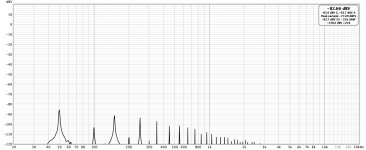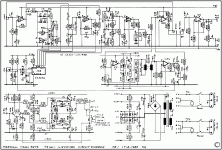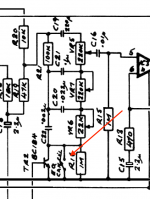Hi everybody,
looking for advice from someone which has more experience with guitar amplifiers (diffent manufacturer build approaches and motivations like in hifi).
In general the noise floor is higher, some buzz hum/level is normal (various guitar pickups, sensitive speakers, chassis shielding standards are lower = the top cover is often wood frame).
The particular amplifier I am trying to fix (solid state Marshall 5275 from 80's) is humming/buzzing more like my previous guitar amplifiers so I am still not 100 percent sure it is normal, but I have found numerous mentions that Marshalls from that era are noisy and they did not bother with hum because it does not matter at band level volume.
This unit is freshly after service where all the usual culprits where handled:
- cracked solder joints checked
- all potentiometers cleaned
- bolts are chacked and fastened
- pcb connections to chassis, checked and cleaned
- input, foot switch, effects loop, external cabinet jack sockets are cleaned
- all electrolytic caps replaced
- all coupling tantualum caps replaced (with bipolar electrolytics)
- preamp power supply zeners replaced
- main rectifier bridge replaced
- factory mods and differences between schematic and amp were reviewed
- opamps were checked and put into socket
- infamous channel switching IC CA3046 was checked
The hum buzz level is exactly like it was before the service. I have measured it with REW on idle via headphones output. Attaching it together with schematics.
The most dominant hum frequencies are basic 50Hz and 3rd harmonic 150Hz.
Transformer itself has mechanical hum and there is also full size spring reverb tank at the bottom.
Any ideas and hints are welcomed.
Thank you.
looking for advice from someone which has more experience with guitar amplifiers (diffent manufacturer build approaches and motivations like in hifi).
In general the noise floor is higher, some buzz hum/level is normal (various guitar pickups, sensitive speakers, chassis shielding standards are lower = the top cover is often wood frame).
The particular amplifier I am trying to fix (solid state Marshall 5275 from 80's) is humming/buzzing more like my previous guitar amplifiers so I am still not 100 percent sure it is normal, but I have found numerous mentions that Marshalls from that era are noisy and they did not bother with hum because it does not matter at band level volume.
This unit is freshly after service where all the usual culprits where handled:
- cracked solder joints checked
- all potentiometers cleaned
- bolts are chacked and fastened
- pcb connections to chassis, checked and cleaned
- input, foot switch, effects loop, external cabinet jack sockets are cleaned
- all electrolytic caps replaced
- all coupling tantualum caps replaced (with bipolar electrolytics)
- preamp power supply zeners replaced
- main rectifier bridge replaced
- factory mods and differences between schematic and amp were reviewed
- opamps were checked and put into socket
- infamous channel switching IC CA3046 was checked
The hum buzz level is exactly like it was before the service. I have measured it with REW on idle via headphones output. Attaching it together with schematics.
The most dominant hum frequencies are basic 50Hz and 3rd harmonic 150Hz.
Transformer itself has mechanical hum and there is also full size spring reverb tank at the bottom.
Any ideas and hints are welcomed.
Thank you.
Attachments
Isolate the problem.
Do ANY of the controls affect the hum in ANY way? COntrols that do are after the source, controls that do not are either before the source or not in the signal path.
Do the work with no instrument connected.
It is actually common for guitar amps to be fully shielded. The open side of the chassis generally bolts up against the top of the cab, which itself is covered by aluminum foil or a thin metal sheet or even screening. Peavey used a black conductive paint. So sometimes the last part of killing hum is to bolt the chassis back into the cab.
Do ANY of the controls affect the hum in ANY way? COntrols that do are after the source, controls that do not are either before the source or not in the signal path.
Do the work with no instrument connected.
It is actually common for guitar amps to be fully shielded. The open side of the chassis generally bolts up against the top of the cab, which itself is covered by aluminum foil or a thin metal sheet or even screening. Peavey used a black conductive paint. So sometimes the last part of killing hum is to bolt the chassis back into the cab.
humming/buzzing more like my previous guitar amplifiers so I am still not 100 percent sure it is normal,
...................
The hum buzz level is exactly like it was before the service
I very much suspect your amp is "normal", like any other amp same model.
High gain amps *are* "noisy" or at least are perceived as such, because they, well, are high gain ...but I have found numerous mentions that Marshalls from that era are noisy and they did not bother with hum because it does not matter at band level volume.
The basic checkup is as Enzo mentioned: check what controls do to hum/buzz.
Is it annoying/unbearable with all controls set to zero?
Thinking Marshall "didn´t care" is unfair, this one is fully comparable to others same era (Peavey, Randall, etc.)
Hi @Enzo, I have spend some time with the unit and tinkered with the controls. The amplifier was mounted into the chassis and warmed up for approx. 10 mins. No instrument connected. Footswitch was connected (without it the both signal routes boost and normal are active).
"Normal" channel
- without E.Q engaged for boost channel the amount/volume of buzz does not change when turning the controls (only regular background noise goes up)
- with Gain (E.Q push-pull) potentiometer pulled forward = E.Q is engaged for boost channel, buzz is lower with master volume on 3 and returns back when master volume is on 7
- buzz lowers when I stick cable do the effect loop RETURN jack
- buzz comes back to initial level when I connect SEND/RETURN with jumper cable
"Boost" channel
- buzz is equal like in normal channel when master volume is on zero
- buzz is lower with master volume on 3 and returns back when master volume is on 7 (E.Q enabled and disabled)
- buzz lowers when I stick cable do the effect loop RETURN jack
- buzz comes back to initial level when I connect SEND/RETURN with jumper cable
Also when the amp was on idle for some minutes new issue occured. Intermittent popping. Single pops, small groups, or even bursts. Some small transistor turned noisy? Already freeze sprayed them when I was looking for some bad solder joint and they did not popped during the test.
The level of hum/buzz is more or less the same when the amplifier case if placed outside or inside the wooden box. This particular model does not have shielded the top part, just bare wood (no foil and no conductive color). Could try to shield it later.
"Normal" channel
- without E.Q engaged for boost channel the amount/volume of buzz does not change when turning the controls (only regular background noise goes up)
- with Gain (E.Q push-pull) potentiometer pulled forward = E.Q is engaged for boost channel, buzz is lower with master volume on 3 and returns back when master volume is on 7
- buzz lowers when I stick cable do the effect loop RETURN jack
- buzz comes back to initial level when I connect SEND/RETURN with jumper cable
"Boost" channel
- buzz is equal like in normal channel when master volume is on zero
- buzz is lower with master volume on 3 and returns back when master volume is on 7 (E.Q enabled and disabled)
- buzz lowers when I stick cable do the effect loop RETURN jack
- buzz comes back to initial level when I connect SEND/RETURN with jumper cable
Also when the amp was on idle for some minutes new issue occured. Intermittent popping. Single pops, small groups, or even bursts. Some small transistor turned noisy? Already freeze sprayed them when I was looking for some bad solder joint and they did not popped during the test.
The level of hum/buzz is more or less the same when the amplifier case if placed outside or inside the wooden box. This particular model does not have shielded the top part, just bare wood (no foil and no conductive color). Could try to shield it later.
Attachments
Last edited:
@nigelwright7557
1/ Poorly screened input circuit. -> could be (hum lowers when the preamp is bypassed via effects loop, indicates that the cause could in preamp)
2/ Poor smoothing and decoupling capacitors. -> all were changed, and the new ones were measured before installation
3/ Magnetic coupling from transformer to circuit, especially input. -> could be, but how to improve this one?
1/ Poorly screened input circuit. -> could be (hum lowers when the preamp is bypassed via effects loop, indicates that the cause could in preamp)
2/ Poor smoothing and decoupling capacitors. -> all were changed, and the new ones were measured before installation
3/ Magnetic coupling from transformer to circuit, especially input. -> could be, but how to improve this one?
Last edited:
@JMFahey
"I very much suspect your amp is "normal", like any other amp same model."
Could be, currently I am more inclined to believe it is broken .
.
"Is it annoying/unbearable with all controls set to zero?" Yep.
"Thinking Marshall "didn´t care" is unfair, this one is fully comparable to others same era (Peavey, Randall, etc.)"
Ok, because they helped to create many from the iconic rock/metal sounds I will reformulate that they did their best effort measured by the era standards.
"I very much suspect your amp is "normal", like any other amp same model."
Could be, currently I am more inclined to believe it is broken
"Is it annoying/unbearable with all controls set to zero?" Yep.
"Thinking Marshall "didn´t care" is unfair, this one is fully comparable to others same era (Peavey, Randall, etc.)"
Ok, because they helped to create many from the iconic rock/metal sounds I will reformulate that they did their best effort measured by the era standards.
when you inspected for cracked & cold solders did you use a magnifying glass?
everything you are describing indicates a loss of ground....or possibly open filters in the pre-amp stage.
and yes high gain amps + loss of ground = noise. then in a test situation everything can be a noise source, fluorescent lighting, the scr controlled solder iron your using to fix things, the computer monitor near the bench....
how can you have troubleshot this amp without removing the pcb from the chassis?
everything you are describing indicates a loss of ground....or possibly open filters in the pre-amp stage.
and yes high gain amps + loss of ground = noise. then in a test situation everything can be a noise source, fluorescent lighting, the scr controlled solder iron your using to fix things, the computer monitor near the bench....
how can you have troubleshot this amp without removing the pcb from the chassis?
this one is hum free and it's not in the box...Marshall 5275 "The Cat" 75 Reverb, HQ Audio - YouTube
@turk 182
yep, magnifier glass was used and everything suspicios was reflowed
PCB can be flipped after controlors nuts unscrewing and after the brown lead which goes from the fuse to the mains switch is unsoldered. I have used the headphones when performed various tests with the amp part removed from the chassis.
I know the video you posted. It was the main reason I have bought the amp . The guy which posted the video refurbished it (did not mentioned lot of details except that he changed potentiometers).
. The guy which posted the video refurbished it (did not mentioned lot of details except that he changed potentiometers).
yep, magnifier glass was used and everything suspicios was reflowed
PCB can be flipped after controlors nuts unscrewing and after the brown lead which goes from the fuse to the mains switch is unsoldered. I have used the headphones when performed various tests with the amp part removed from the chassis.
I know the video you posted. It was the main reason I have bought the amp
No proper "full ground test" was performed yet. Assembled the amp for Christmas sound testing  .
.
I did only my "usuall suspects" list when it was on bench:
- potentiometers covers/shafts chassis contact checkup and nuts retightening
- main connection from pcb to chassis (distancing pin cleanup, retightening and measurement)
- safety ground resistance check
- filters caps check
- diodes check
- even unsoldered some parts which measured weird in the circuit (were OK out of circuit)
- board flexing, parts tapping, freeze spraying, ...
- fixed cracked track near the boost channel volume pot
The caps were actually in good condition, with exception of two tantalums (one was failed ... high capacitance, high resistance, and one was out of spec).
I did only my "usuall suspects" list when it was on bench:
- potentiometers covers/shafts chassis contact checkup and nuts retightening
- main connection from pcb to chassis (distancing pin cleanup, retightening and measurement)
- safety ground resistance check
- filters caps check
- diodes check
- even unsoldered some parts which measured weird in the circuit (were OK out of circuit)
- board flexing, parts tapping, freeze spraying, ...
- fixed cracked track near the boost channel volume pot
The caps were actually in good condition, with exception of two tantalums (one was failed ... high capacitance, high resistance, and one was out of spec).
Last edited:
when it comes to the pots did you ensure the phenolic's are not cracked and that all the pin pressings where ok?
with no plug in the input what do get across the tip and sleeve positions for resistance?
do you have the means to upload pic's?
is your AC source grounded?
i once neglected proper hardware and failed to notice that the pot was bridged by the chassis...
with no plug in the input what do get across the tip and sleeve positions for resistance?
do you have the means to upload pic's?
is your AC source grounded?
i once neglected proper hardware and failed to notice that the pot was bridged by the chassis...
Last edited:
The pots are working, detailed measurements of each were not performed. On pot was replaced for smaller variant by some historic repair, I have measured only that one, it looked ok.
But I should probably return to them.
What pics would like to see exactly?
AC source is grounded.
But I should probably return to them.
What pics would like to see exactly?
AC source is grounded.
- Status
- This old topic is closed. If you want to reopen this topic, contact a moderator using the "Report Post" button.
- Home
- Live Sound
- Instruments and Amps
- Marshall Reverb 75 (5275) - Hum issues


